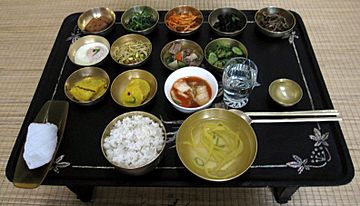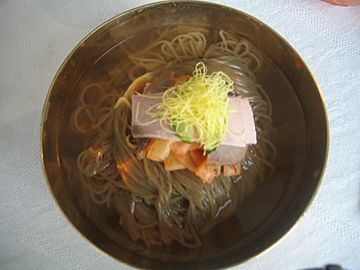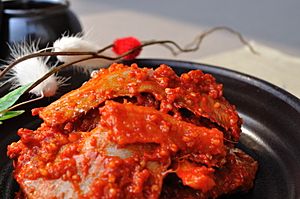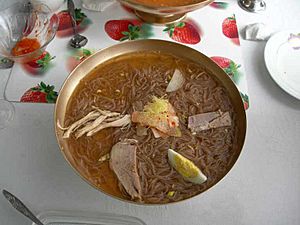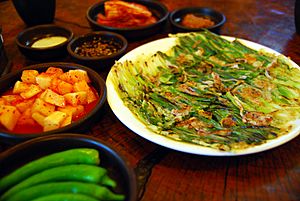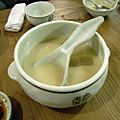North Korean cuisine facts for kids
North Korea is a country in East Asia, located on the northern part of the Korean Peninsula. It shares a border with South Korea to the south, separated by the Korean Demilitarized Zone. The food in North Korea has a long history, growing from ancient farming and nomadic traditions. Many dishes are similar to those in South Korea, but in North Korea, how much and what kind of food people can get often depends on their social class.
Traditional Korean meals often include rice dishes and kimchi as main foods. These are usually eaten with side dishes called Banchan and main courses like juk, Bulgogi, or noodles. Soju is a well-known traditional Korean drink.
Contents
North Korean Food Styles
Many foods found in North Korea are also made in South Korea. After the Korean War, many families moved from North Korea to South Korea, bringing their traditional recipes with them. These dishes then became popular in South Korea too.
North Korean dishes often taste a bit different from South Korean ones. They can be less spicy and have more varied ingredients. People describe North Korean food as having a special tangy taste, which comes from mixing sweet, sour, strong, and spicy flavors.
Some restaurants, especially in Pyongyang, the capital city, are quite expensive. Most regular North Koreans cannot easily go to these places. They are usually for tourists, government leaders, and a wealthy group of people called donju. Donju means "masters of money." These people often work for the government or bring goods into the country.
You can also find street food in North Korea, with vendors selling food from food stalls, especially in Pyongyang. North Korea even got its first pizzeria in 2009! Alcoholic drinks are made and enjoyed in North Korea, and the legal drinking age is 18.
Popular North Korean Dishes
Here are some common foods and dishes you might find in North Korea:
- Barley
- Beef rib soup
- Bellflower
- Chapch'ae – a dish of glass noodles mixed with vegetables and meat.
- Chicken
- Chinese cabbage stew
- Jokbal – pig's trotters (feet) cooked in soy sauce with spices like onion, garlic, and cinnamon.
- Cookies
- Corn – North Koreans often grind corn, sometimes even including the cobs and husks, to make it last longer.
- Edible mushrooms – like wild pine mushrooms.
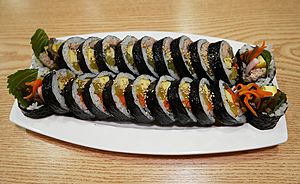
- Gajami shikhae – a fermented and salted dish made with flounder, quinoa, garlic, ginger, and chili flakes.
- Herbs and greens – used in cooking and salads.
- Hot pot – a communal dish where ingredients are cooked in a simmering broth.
- Kimbap – rice and other ingredients rolled in dried seaweed.
- Kimchi – very common, eaten with almost every meal. It's important in winter when fresh vegetables are hard to find.
- Kkakdugi – kimchi made from diced radish.
- Kogi bap – a rice dish with artificial meat, popular street food.
- Injo kogi – sausages made from soybeans.
- Injo kogi bap – cooked rice wrapped in a skin made from leftover soybean paste.
- Korean chestnut
- Mandu – different kinds of dumplings. Styles vary by region.
- Meats – meat is not eaten often by most people. It's usually available during holidays like the birthdays of Kim Il-sung and Kim Jong-il, when the government gives out extra meat. Pork, rabbit, and sometimes goat are eaten. Beef is mostly not allowed, except for small amounts in stews or soups.
- Millet
- Miyŏk-kuk – a healthy vegetable soup made with seaweed.
- Noodles and noodle dishes – long noodles are a symbol of a long life or a long marriage, often served at weddings.
- Beef noodle soup
- Corn noodles
- Raengmyŏn – a traditional cold noodle dish made with buckwheat noodles. It often includes meat slices, dried egg, and hot sauce. Some versions have raw fish, cucumber, and Asian pear. Many North Koreans believe this dish started in North Korea.
- Ramen – called "curly noodles" in North Korea. Shin Ramyun, a South Korean instant noodle brand, is nicknamed "money ramen" because it's very expensive for most North Koreans.
- Rice noodles
- P'ajǒn – a savory pancake, often made with seafood and scallions.
- Panch'an – side dishes served with full meals. They are usually spicy, salty, or tangy, and many are fermented for extra flavor.
- Pheasant
- Pibimpap – white rice mixed with vegetables and other ingredients.
- Tolsot pibimpap – pibimpap served in a hot stone pot.
- Pickled cucumber
- Pindae-ttŏk – a fried pancake made from mung beans, green onion, and kimchi.
- Porridge – a common food in North Korea.
- Potatoes and potato dishes.
- Pulgogi – marinated and grilled beef.
- Quail eggs and quail egg jelly.
- Rice – short-grain rice is a main food.
- Rice cakes
- Seafood – seafood dishes and raw seafood are part of the cuisine and are a main food source.
- Alaska pollock
- Clams
- Cod
- Kimbap sushi
- Gray mullet fish soup
- Octopus
- Salmon and raw salmon
- Seaweed
- Shinsŏllo – an elaborate hot pot dish.

- Snack foods – like kangjǒng (sweet rice puffs), cookies, and cotton candy.
- Sundae – traditional Korean sausages, a popular street food.
- Sungŏ-kuk – a fish soup.
- Tangogikuk – a traditional soup that uses dog meat.
- Tofu – a main food.
- Tofu bap – a tofu and rice dish, common street food.
- Tot'ori-muk – acorn jelly.
- Ttŏk – sticky rice cakes, sometimes with fillings.
- Turkey
- Yakpap – a sweet dish made with steamed sticky rice, chestnuts, dates, and honey.
Condiments
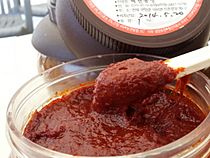
Condiments used to add flavor to North Korean foods include:
- Bean paste
- Garlic
- Ginger
- Gochujang – a red chili pepper paste.
- Pepper flakes
- Sesame oil
- Soy sauce
Beverages
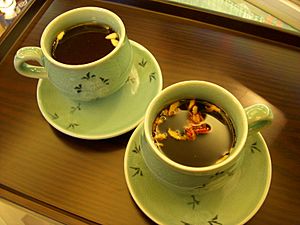
- Bottled water – often imported from China and mostly bought by the donju (wealthy class). "Shindŏk' Saemmul" is North Korean spring water, but it's mostly sold to other countries.
- Coffee
- Instant coffee – some instant coffee is made in North Korea.
- Ginseng tea – a common drink.
- Soft drinks – North Korea has its own soft drink companies. Their drinks are sometimes called "carbonated sweet water." Air Koryo, North Korea's airline, even has its own brand of soft drinks. Coca-Cola and Pepsi from China can be found in some stores, but Pepsi is rarer.
- Ryongjin Cocoa – a North Korean cola brand.
- Taech'u-ch'a – a traditional Korean tea made with jujube fruit and pine nuts.
Alcoholic Beverages
Alcoholic drinks are part of North Korean culture. The legal drinking age is 18. Some North Koreans make their own alcohol at home, even though it's not allowed. They use ingredients like potatoes and corn. Imported Chinese alcohol, like Kaoliang Liquor, is also sold.
Pyongyang has bars and beer halls, which have become popular.
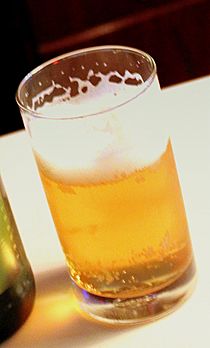
- Beer – North Korea produces beer, and craft beer making has grown. Major breweries include Taedonggang Brewing Company. In 2016, North Korea held its first beer festival.
- Beer brands made in North Korea:
- Pohak
- Ponghak
- Pyongyang
- Rakwon ("Paradise")
- Ryongsong
- Samgak ("Delta")
- Taedonggang – the most popular beer in North Korea in 2017.
- Beer brands made in North Korea:
- Makkŏlli – a milky rice wine, common in the countryside. It has less alcohol than soju.
- Rice liquor – more North Koreans drink rice-based liquor than beer.
- Rice wine – sticky rice wine is a special drink.
- Soju – a clear spirit made from sweet potato or barley. It's similar to sake and usually has 18 to 25 percent alcohol.
- Whisky – North Korea made its first homemade whisky, Samilpo Whisky, in 2019.
Images for kids
-
Unseasoned tot'orimuk
-
Mapo tofu originated in China, and is consumed in North Korea
-
Street food vendors in Pyongyang, North Korea
-
Dried pollock at the Rakwon Paradise Microbrewery. Dried pollock is a typical bar snack in some areas of North Korea.
-
Lunch at a restaurant in Kaesong
-
Coffee beans and an espresso machine at a coffee shop located next to the Pyongyang Hotel in Pyongyang, North Korea
-
The karaoke room bar in the Masikryong Hotel, located at the Masikryong Ski Resort in North Korea
-
An example of makgeolli
fr:Culture de la Corée du Nord#Cuisine(s)


